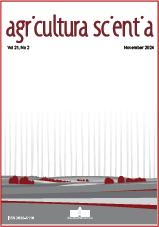The Adverse Impacts of a Single Exposure to the Fungicide Picoxystrobin during the Larval Stage on Africanized Apis mellifera
DOI:
https://doi.org/10.18690/agricsci.21.2.4Keywords:
development, honey bee, non-target organism, strobilurin, toxicityAbstract
Pesticide use remains a problem in agriculture, contaminating natural ecosystems and affecting bees. Fungicides have been widely used worldwide, and honey bees can bring contaminated pollen and nectar to the colony, exposing the larvae. Studies on larval exposure to fungicides are still rare. Therefore, this work aimed to evaluate the effects of larval exposure to the fungicide picoxystrobin on biological parameters and cellular stress in the fat body. The larvae were single exposure on the fourth day (D4) to picoxystrobin at concentrations of 5 ng a.i./μL (PCX5), 45 ng a.i./μL (PCX45), 135 ng a.i./μL (PCX135), and 400 ng a.i./μL (PCX400). The effects on larval and pupal mortality, pupation rate, and emergence were evaluated. Additionally, cellular stress in the fat body was assessed in newly emerged bees. Exposure to PCX400 increased larval mortality by 26% and reduced the emergence of adult bees. The other concentrations did not affect larval and pupal mortality, or pupation and emergence rates. A cytotoxicity effect was observed in newly emerged bees from PCX400, indicated by positive immunolabeling of HSP70. Thus, a single exposure to picoxystrobin can impair larval development, induce a cellular stress response, and may interfere with colony dynamics.
Downloads
Downloads
Published
Issue
Section
License
Copyright (c) 2025 Caio Eduardo da Costa Domingues, Leticia Salvioni Ansaloni, Aleš Gregorc, Elaine Cristina Mathias da Silva

This work is licensed under a Creative Commons Attribution-NonCommercial-NoDerivatives 4.0 International License.
